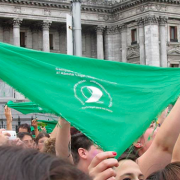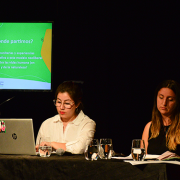Blame it on the media
On July 21, in the central news show on Canal 12 in Córdoba, journalist Fabiana Dal Prá interviewed a rape victim. We denounced before the Public Defender’s Office, her approach, which was an example of media and symbolic violence, showing how much there is still no training in gender perspective in the media.
“Do you blame yourself for something?” Dal Prá asks after a woman on her back recounted her painful experience, visibly moved. Dahyana, the young Cordovan woman who was sexually assaulted in the Ampliación Las Palmas neighborhood responds forcefully that she is not guilty of anything, that she has been the victim of a sex crime.
It is not the first time that the journalist has committed symbolic and media violence. In 2019, in the case of Lautaro Teruel, accused of sexual abuse of a ten-year-old girl, he described the fact on the air as a “mistake”. The same thing happened in 2018, when interviewing a young woman who had been abused in the vicinity of the Kempes Stadium, who asked her, after the account of the events: “Are you sorry for how you reacted?”.
This approach to sexual abuse cases, focusing on the victim’s guilt and questioning their actions, only manages to minimize the fact of physical and sexual violence to which they were subjected through re-victimization and stigmatization. This treatment is an exercise in media violence, not only towards the victim who is exposed and questioned, but also towards other women and femininity who are part of the audience and may have experienced situations of the same type. The impact of a journalistic action of these characteristics is enhanced by the breadth of the scope of the channel and the program’s central schedule.
Nor is it the first time that Canal 12 commits these forms of gender violence nor the first time that it receives public condemnation. This recidivism does nothing more than make evident the lack of commitment of the environment with the visibility, prevention and fight for the eradication of the different types and modalities of gender violence.
In this situation, we denounce the facts before the Public Defender, the administrative body that protects the rights of the hearings, so that it analyzes the interview and intervenes, making recommendations to the media.
Symbolic and media violence in the media
The media are key actors in the construction and reproduction of meanings and values that can legitimize or transform violent practices, behaviors and ways of understanding the world. They are actors who have the possibility of building a more just and equitable society through the deconstruction of gender roles and stereotypes that violate LGBTIQ + women and people.
Unfortunately this is not the case, despite being recognized by law. We are, once again, before a medium that systematically exercises symbolic and media violence in accordance with the definitions of Law 26,485 on Comprehensive Protection to Prevent, Punish and Eradicate Violence against Women, and which are also contemplated in Law 26,522 on Services of Audiovisual Communication.
Media violence is one that through stereotyped patterns, messages, values, icons or signs, transmits and reproduces domination, inequality and discrimination in social relations, naturalizing the subordination of women in society.
Symbolic violence is any publication or dissemination of stereotyped messages and images through any mass media, which directly or indirectly promotes the exploitation of women or their images, injures, defames, discriminates, dishonors, humiliates or attempts against dignity of women, as well as the use of women, adolescents and girls in pornographic messages and images, legitimizing unequal treatment or building sociocultural patterns that reproduce inequality or generate violence against women.
To avoid these types of violence when dealing with cases of sexual abuse, the Public Defender’s Office has a Guide for the responsible treatment of cases of violence against women, in which it indicates that it is necessary to “dispense with approaches that stigmatize, blame , they disbelieve and / or sexualize women in situations of violence ”, as well as“ privilege approaches focused on prevention and awareness of the social problems of violence against women, regardless of the spectacularization and fictionalization of cases.”
It is urgent that the media and journalists are trained and sensitized to develop communication with a gender perspective, egalitarian and non-sexist, but fundamentally, that they put aside these violent practices.
The only appropriate and responsible way of addressing violence against women through the media is starting from a perspective that respects human rights and is committed to the prevention and eradication of violence.
More information
- CISPREN Press Release: Media with a Gender Perspective
- The show of violence | Fundeps – September, 2015
- Available ?: Denounce Arriba Córdoba on Channel 12 for media violence | Fundeps – September, 2018
- The Morning Show again incurred media violence | Fundeps – January, 2019
Contact
- Cecilia Bustos Moreschi, cecilia.bustos.moreschi@fundeps.org











